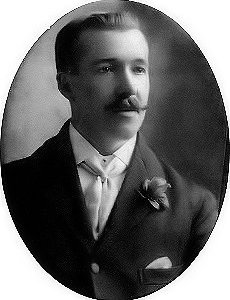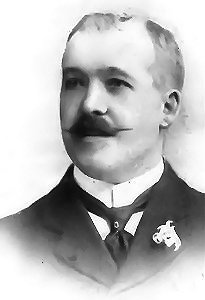Hughes’ family moved to Swansea when he was around two years old. He is sometimes confused with the John Hughes who wrote the tune Cwm Rhondda.
After following his usual duties at the works on Monday 15th June 1914, John Hughes at night drove an employee, who had a piece of steel lodged in his hand, from Morriston, to the Hospital.
It was late when he retired, in his usual cheerful mood, apparently in the best of health, but he soon became ill and his death at 6.45 am on Tuesday morning, the 16th June 1914, was caused by a clot of blood on the brain. He died at his residence No. 3 Stockwell Villas, Mount Pleasant, Swansea.
He left a widow and three small children. All his friends were extremely grieved to hear of his untimely death at the age of 42.
His death deprived the Duffryn Works of a highly capable manager. John’s fresh colour and robust appearance generally flattered, only to deceive. His sad demise came as a great shock to the inhabitants of Morriston, where he was personally known to almost everyone.
He died at number 3 Stockwell Villas, Swansea, on the 16th June 1914, aged forty-two, and was buried in the cemetery of Caersalem Newydd Welsh Baptist Chapel in Treboeth, with his parents.
On Saturday 20th June 1914, there was a large and representative gathering at the funeral which took place on Saturday 20th June 1914 at Caersalem Newydd Welsh Baptist Chapel burial ground, at 4 pm.
Prior to the departure of the cortege from his house, the well know hymn Ymadownaf a’r babell was sung by the Philadelphia choir, conducted by John Humphries.
A short service was held at the house, when the Reverend W. Evans, Cross Keys and the Reverend B. O. James, Cross Hands officiated.
As the procession wended its way towards the graveside Calon Lân, one of his best known compositions, was sung with much feeling. An impressive service was held at Caersalem Chapel, where the Reverend E. G. Hughes (Ravenhill), D. B. Richards (Brynhyfryd), D. Thomas (Landore), D. Pryse Williams (Philadelphia) and D. Price (Bethesda) paid their last tribute to the departed. The hymn, Dilyn Iesu was also sung.
The service at the graveside was very impressive, and the massed choir feelingly rendered Crugyher. The last rites were performed by the Reverend D. James (Morriston) and J. Davies (Mynyddbach).
The mourners were Mrs. John Hughes (widow), Mrs. Hughes (mother), Mrs. Bessie and May Hughes (daughters). Other mourners were representatives of the Dyffryn Works, Morriston, of which the deceased was for some years Manager; the works owner, W. H. Edwards (proprietor). Amongst the members of the general public was Leon Vermont (London), Councilors David Matthews J.P. John Lewis Swansea. Employees of the Dyffryn Works Morriston, acted as bearers.
It is worthy of note that many of the hymn tunes sung at the funeral were of John Hughes’ own composition. On Sunday afternoon and evening sympathetic references were made at the Tabernacle Chapel Morriston, of the loss sustained by the untimely death of John Hughes and as a last tribute two of his most popular compositions Dilyn Iesu and Calon Lân were rendered.

